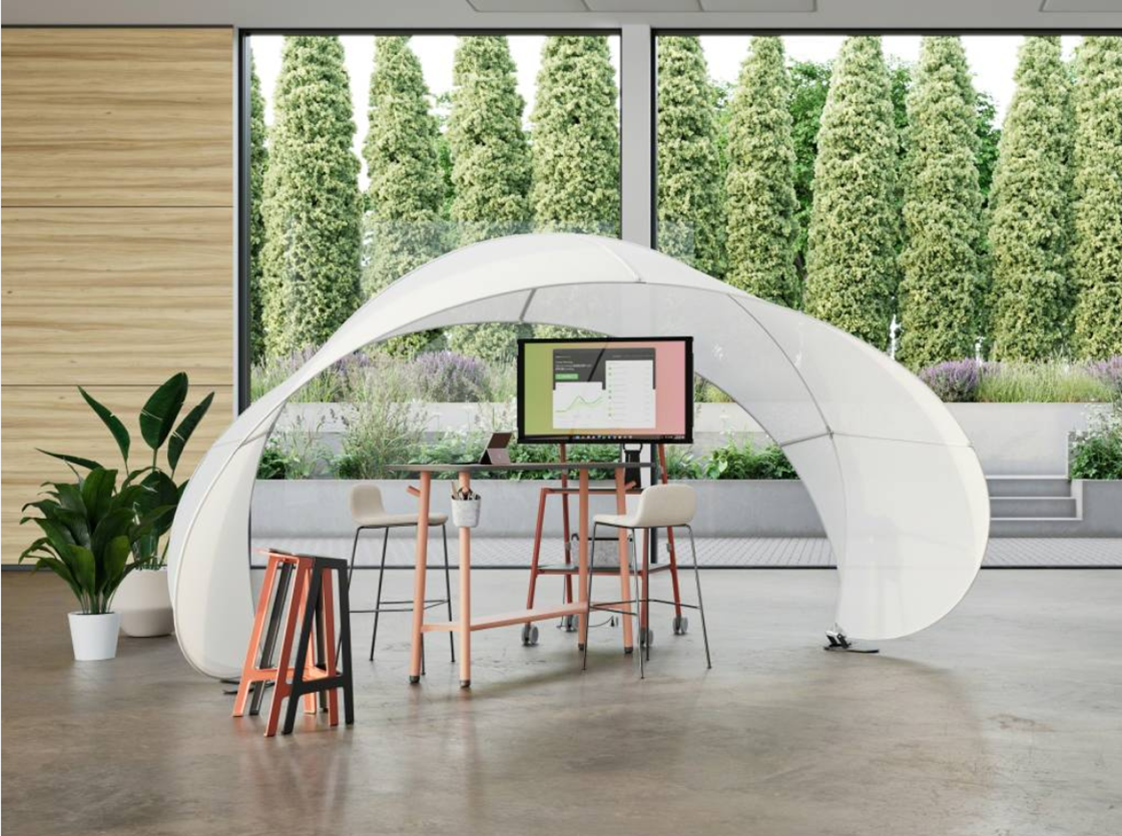
Why the return to the office could get more ‘in-tents’
Every now and again, two seemingly divergent ideas work together. Peanut butter and jelly anyone? I’d like to propose another unlikely combo: offices and tents. On the face of it, it may seem crazy, but this idea is backed by solid research.
Last year we spoke to 5,000 workers about what they wanted from a modern hybrid work experience. The most appealing attribute of home working for two-thirds (65%) was that they got to have a dedicated workspace. It, therefore, became clear that giving staff their own private space in the office could be an important part of creating an environment that would tempt them back into the office. However, with most modern offices set up to be open plan and offering minimal privacy, this provides a problem for businesses.
priv·acy [ˈprɪvəsi, ˈprʌɪvəsi] NOUN
- a state in which one is not observed or disturbed by other people
Shelter and privacy
Separate research conducted by the University of Wisconsin shows that visual distractions can interrupt focus, often more than noise. What this shows us is that whilst privacy is key, the dedicated workspace doesn’t need to be soundproof to be effective. Sometimes the best solution is one that has been around for millennia. One of the earliest forms of shelter and privacy known to man is the trustworthy tent. Whilst it may be just a piece of fabric, a tent has the psychological ability to bring comfort and feelings of safety. But how do you make something more commonly seen at festivals and campsites work in the office environment?
This became an irresistible challenge for Chris Pottinger, an industrial designer who has spent his career designing outdoor equipment ranging from sleeping bags to backpacks for companies like Big Agnes, North Face and REI. “Tents inherently make you feel comfortable and safe when you’re inside of them,” he explains. “The idea of bringing tents to the workplace is so innovative and something I had to be a part of.”
Tinkering and testing
Pottinger and the team conducted a series of intense (pun intended!) design sprints and began experimenting with tensile structures – a construction of elements carrying only tension, no compression or bending. Rapid prototypes were created using pipe cleaners, string, and duct tape. From these, a few were chosen for larger-scale tinkering and testing. Then there was the question of finding the right material that would provide shelter, privacy, and light. An opaque material was found to work best.
Whilst the finished tents may look different to what you’d find at Glastonbury, the original inspiration shines through and is a perfect solution for anyone who needs a little control over their privacy at work.
Sometimes the simple solutions are the best. In contrast to the heavy, linear expressions found in many workplaces, tents feature light, airy, organic shapes. The simple screens and small enclosures give staff unexpected and playful — yet hard-working — alternatives to help protect them from office distractions. Whether used as space for an individual desk or a team lounge setting, tents can help staff feel comfortable and shielded, so that they can get on with what they need to be doing.

Reimagined the office space
The popularity of tents is rooted in the human desire to seek shelter and protection from natural elements. Whilst recreational tents provide safety and a haven of security in uncertain outdoor conditions, work tents provide people in the office with the same shelter and protection they crave. With a tensile construction, they pair light and airy organic shapes with tent-like and sheer textiles to create a range of flexible and captivating privacy solutions. They challenge conventional privacy solutions by offering a novel and compelling way for people to work.
It is my view that using tents to provide private workspaces could be the catalyst needed to get staff back into the office in numbers. They can be the perfect retreat from common office distractions, providing a comfortable, private working environment for focus or rejuvenation. Tents, with their unique and organic shape, can add a compelling and unconventional visual aesthetic to the modern workplace.
Make them smile
With expectations shifting, working in the office needs to be an enjoyable prospect for staff to tempt them back. In an effort to curb the great resignation, organisations need to re-design their office space to become an environment that is suited to the hybrid working style craved by workers. However, budgets remain tight.
The benefits of tents are numerous. They are versatile for multiple uses, flexible and easy to move, provide decent ventilation and are a fraction of the cost of traditional stand-alone pods and enclaves. More than that, they provide staff with their own workspace within the office to re-enforce their sense of belonging and highlight how much they are valued by the business. They help staff work and make them smile. It’s a win, win.

